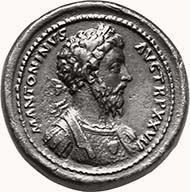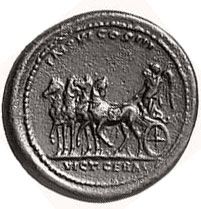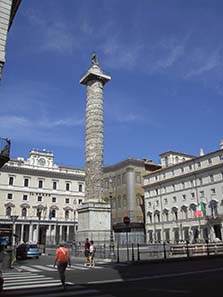by courtesy of Dr. Hans Voegtli / ACAMA
In the middle of the 2nd century AD the tribe of the Goths left its native homeland. The tribesmen moved southwards and expelled other people from their homes who in their turn tried to find new land further south. One of these tribes were the Marcomanni. Their migration came to an early end at the Roman Limes. The migrants could see the rich and fertile lands of the Roman Empire behind this well guarded frontier. It was only natural that they tried to invade the Roman territory.
MARCUS AURELIUS, 161-180. Bronze medallion, 172-173. M ANTONINVS – AVG TR P XXVII Bust of Marcus Aurelius right, laureated, wearing cuirass adorned by head of Medusa. Rev. IMP VI COS III / VICT GERM Victory, in quadriga left. 58,41 g. MIR 1056. Gnecchi 63/7. C. 993. Brown patina.
Roman officers noted the first indications of unrest in the summer of 166 AD. That was the reason for Marcus Aurelius and Lucius Verus to visit the border areas. They wanted to see on-scene what was going on in order to be able to react adequately to the Marcomannic threat. While returning to Rome, Lucius Verus died of the plague
that claimed victims within the whole Roman Empire. Marcus Aurelius came back to Rome without colleague. His stay only lasted some months. In the autumn of 169 he had to return to the border provinces. The Marcomanni prepared the crossing of the Danube.
The column of Marcus Aurelius at the Piazza Colonna in Rome depicts scenes from the Marcomannic Wars.
Marcus Aurelius started to organize the defense. Coins were minted featuring a lot of allusions to the campaign ahead: We can see the emperor leaving Rome on horseback or addressing his soldiers with an encouraging speech. Victory is shown to conjure up the victory over the Marcomanni. Everything was done to win the favor of the gods. Marcus Aurelius sacrificed for example two lions by throwing them into the Danube. Alexander of Abonuteichos the self appointed prophet of the snake-god Glykon had sent an oracle to the emperor. According to Lucian (Alexander 48) he instructed Marcus Aurelius to celebrate the sacrifice in the way mentioned above.
We can see a depiction of this scene on the column of Marcus Aurelius in Rome. Unfortunately Alexander was an incompetent prophet. The sacrifice was no success. The Marcomanni and their allies crossed the Danube and destroyed the Roman army utterly. Our sources claim that 20.000 legionaries were killed during this attack. The Germanic tribes headed along the east side of the Alps for Northern Italy. Enemies had not threatened this region for more than a century. Aquileia was besieged, Opitergium – a small town nearby – completely destroyed.
Marcus Aurelius reacted immediately. He is said – according to the Historia Augusta, Marc. 21, 9 – to have put up the imperial treasures for auction. He needed the money to organize the defense. Perhaps the two new legions, Legio II pia and Legio III concors, both later called Italica, were recruited in this historical context.
In 171 the first success of this effort could be seen. The general Hevius Pertinax – who after the murder of Commodus was emperor for a short time – was able to drive back the Marcomanni and their allies. Marcus Aurelius gained another victory over the barbarians who were trying to retreat over the Danube. His troops acclaimed him Imperator for the sixth time on the occasion of this success. One year later, another tribe could be destroyed. The Iazyges had tried to withdraw over the frozen river Danube. The Roman army followed and won the place.
Our medallion celebrates these victories. None of them is meant in special – the reverse celebrates the eternal ability of Rome to win the victory over any enemy who would dare to threaten the Empire. It was struck at the end of 172 AD to be presented by the emperor to some of his faithful subjects. Marcus Aurelius is shown as commander in chief. He wears the cuirass adorned by the head of Medusa. The emperor didn’t have much chance to take off his armor. Living only eight more years, he spent six of them in camps. It was his son Commodus who was able to end the wars with the Germanic tribes by negotiations.
The chronological order of the Marcomannic Wars is very puzzling. Concerning the fundamental items we are following the newest article of W. Scheidel.
A. Birley, Marcus Aurelius. A Biography, New Haven – London 1987 (2. Auflage).
W. Scheidel, Der Germaneneinfall in Oberitalien unter Marcus Aurelius und die Emissionsabfolge der kaiserlichen Reichsprägung, in: Chiron 10 (1990), 1-18.
W. Szaivert, Moneta Imperii Romani. Die Münzprägung der Kaiser Marcus Aurelius, Lucius Verus und Commodus (161/192), Wien 1986.






